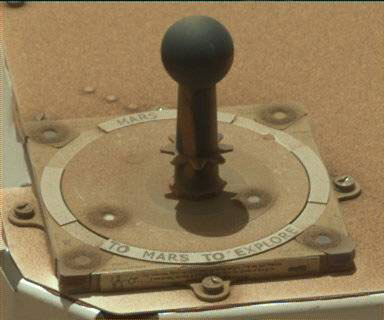3 min read

"Momento" is an order, in Latin, to remember. For myself, as we are entering this four sol planning cycle over the US Memorial Day weekend, I remember my grandfather who fought in World War II, and who started my interest in geology at a young age by showing me pieces of granite (my home town, Quincy, Massachusetts, was renowned for its many granite quarries) and telling me their story. I also remember Curiosity bears mementos from both the Spirit and Opportunity rovers. For example, the Mastcam calibration target is in the form of a sun dial, or “Marsdial,” a modified flight spare from several made for the previous rovers, carrying inscriptions for future explorers to discovery. As the past week has been challenging with struggling lens covers and masts, I remember that every day we can get an image or science observation from Curiosity is a day to celebrate all its done and that every day is something special to remember what it's accomplished.
If the rover completes the next four sols with their numerous observations, it will be a very good set of days to remember indeed! We start with a whisper of environmental observations in the morning on sol 3132 with a ChemCam passive sky observation, Navcam large dust devil survey and line-of-sight observation (measuring dust opacity), and Mastcam color rim extinction (more dust observations within the crater). For the afternoon, a Mastcam tau observation, Navcam cloud movie, and other sky observations. On sol 3133, there even more Navcam dust devil and horizon movies before we start looking at rocks (my favorite part!) with Mastcam mosaics across the bedrock looking for potential lineations or scours across the undulating surface. Moving on to sol 3134, the rover investigates targets "Fossemagne" and "Festalemps" with ChemCam passive observations, though only after we give them a good scrubbing with the Dust Removal Tool (DRT) and APXS observations both before and after. The rover will take Mastcam multispectral documentation images of the area to further characterize their composition and better understand how these rocks look on the ground compared to what we see from orbit. Another Mastcam image will also be taken of a previous APXS target, "Villars." Finally, on sol 3135 before a 70 meters drive, a final ChemCam five shot horizontal observation on "Champsac" will help characterize the chemistry in front of the rover before we leave it. As the rover arrives at its new destination, it will take a Navcam view right before it parks, a Mastcam clast survey and solar tau, MARDI will take images beneath the rover, and a post drive Navcam mosaic for a view of the rocks there and ahead.
Enjoy your weekend and remember those who served, those who you are with, and what new events lie ahead in your future.
Written by Fred Calef, Planetary Geologist at NASA's Jet Propulsion Laboratory







